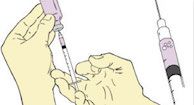Does this make any sense? I was a fairly settled diet-controlled (with Metformin) Type 2 diabetic. But now I have had 9 months of ovarian cancer with 6 courses of chemo and a big operation. All treatment finished 3 weeks ago. During the chemo the short-term steroids pushed my BG sky high and when the prescribed Glicklazide didn't fix it I was started on the Abasaglar insulin each evening. So now the position is that I just have that Absaglar (8 units) but I had a test which apparently SEEMS to show that I may be Adult Onset Type 1. My questions, if anybody can help or advise, are how likely I am actually to revert to simple diet-controlled T2 again now all the treatment is over? I hate injecting insulin, I am very underweight, have little fat to inject it in and bruise constantly. How different is the management of T1 and T2 and what should I expect? And then I read somewhere that there's some sort of pump you can have inserted INTO your body that automatically dispenses the right amount of insulin whenever you need it. Is this just a rumour or something still in trial? I'm desperate to avoid more injections!
Can anybody make any sense of this? I'd really love to know what to expect....
Can anybody make any sense of this? I'd really love to know what to expect....


